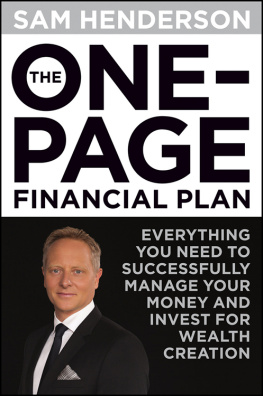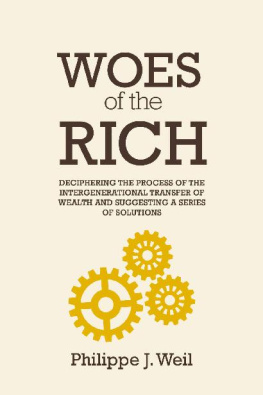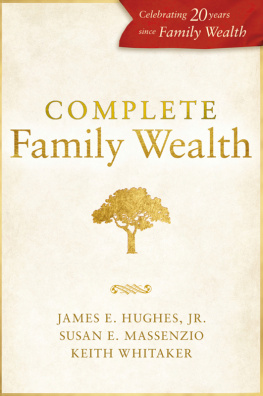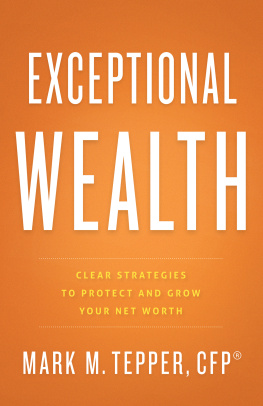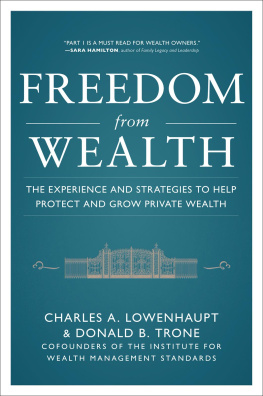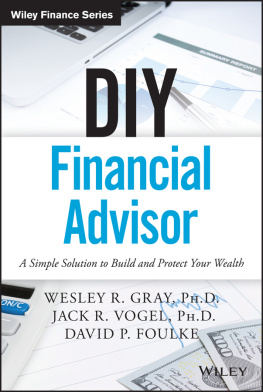Thank you to my family and my clients.
Without my family, I would not exist. Without my clients, LaGrande Global would not exist.
1 WHY READ THIS BOOK
As to methods there may be a million and then some, but principles are few. The man who grasps principles can successfully select his own methods. The man who tries methods, ignoring principles, is sure to have trouble. Ralph Waldo Emerson, poet
You will either like this book and want to work with me, or you will disagree with my ideas. I have unconventional views on managing private wealth and believe the financial industry fails to properly serve families and their advisors.
These are my Principles, defined as fundamental truths or propositions that serve as the foundation for a system of belief or behavior or for a chain of reasoning. I believe these principles are applicable to families around the world, regardless of geography. As such, the book often focuses on general ideas rather than specifics, as regional differences can vary enormously, e.g., taxes. At their core, however, the principles of managing private wealth remain the same.
This is not a book about investing, and I do not speak about how to analyze individual stocks or bondsmany minds more brilliant than mine have written on the subject. This book contains principles for effectively managing a familys private wealth.
Leonardo da Vinci stated, Art is never finished, only abandoned. Like da Vinci, I view this book as unfinished, though it would be presumptuous of me to call it art. It is a living, breathing document and will continually be refined, expanded and changed over time. Welcome.
Footnotes
Definition of Principle in English. Principle: Definition of Principle in Oxford Dictionary (American English) (U.S.). Oxford University Press, n.d. Web. 01 Nov. 2015.
PART ONE: INVESTING
2 WHAT INVESTING IS
Invest (verb): To commit money in order to earn a financial return. Merriam-Webster Dictionary
Defining Investing
I will start by explaining a simple but often misunderstood concept: investing and the basics of investing math. Investing is committing money today to receive more money in the future after inflation, taxes and expenses.
Four components apply for the definition of investing, briefly discussed below but in greater depth in future chapters.
Expectation of more money in the future. Investors expect to have more money at the end of the investment period than at the beginning. No one invests expecting losses.
Inflation. Inflation is a persistent, substantial rise in the general level of prices related to an increase in the volume of money and resulting in the loss of value of currency. In other words, $1 today is worth less than $1 tomorrow considering inflation because prices of goods and services generally increase over time (except under deflation). An investment should increase in value at a rate higher than inflation. Otherwise, in real terms, the investment has lost money (real terms being the amount of money today, i.e., the nominal amount, adjusted by inflation). Money, in this case, refers to purchasing powerthe number of goods and services that can be consumed with the current amount of money.
Taxes . Taxes are a compulsory contribution to state revenue, levied by the government on workers income and business profits or added to the cost of some goods, services, and transactions. Taxes have been integral to societies for centuries. Tax rates vary by country and negatively impact investment returns.
Expenses . Expenses include items such as commissions, product fees, management fees and other potential costs related to investing. These expenses are detrimental to investment returns.
Many forget that when considering the wide range of potential investment strategies, vehicles and asset classes, the objective of investing remains the same. Investing is committing money today to receive more money in the future after inflation, taxes and expenses.
The Objective
Rule Number 1: Never lose money. Rule Number 2: Never forget rule Number 1. Warren Buffett, investor
What does it mean to make a good investment? Many factors need to be considered, such as the time horizon, spending and the liquidity needs of the family. Some families require a 4% annual return over time, while others may need 8% or possibly 15%. A good investment is simpleone that generates the required rate of return for the family after inflation, taxes and expenses.
Understanding Investing Math
Good and evil both increase at compound interest. That is why the little decisions you and I make every day are of such infinite importance. C. S. Lewis, author
It is essential to understand compounding, as it is perhaps the most important mathematical concept for managing private wealth. The longer the time horizon, the more important it is for a family to understand how compounding works.
Compounding is the ability of an asset to generate earnings, which are then reinvested in order to generate their own earnings. In other words, compounding refers to generating earnings from previous earnings. Compounding has a profound effect on investment returns, amplified by long investment horizons. To illustrate the power of compounding, I will examine several scenarios.
30-Year Time Horizon
In the following table, three example portfolios are shown, each starting with a $1 million investment growing at 7% annually. I explore the effects of compounding over time (taxes and expenses are excluded in this example).
- Base Case: $1 million grows at 7% annually for 30 years with no dividends.
- 10-Year Delay: $1 million is invested at 7% annually starting 10 years after the base case (for 20 years of total growth), with no dividends.
- 1% Dividend: $1 million grows at 7% annually for 30 years, with a 1% dividend reinvested into the portfolio.
Year | Base Case | Base Case with 10-Year Delay | Base Case with 1% Reinvested |
| $1,000,000 | $1,000,000 |
| $1,967,151 | $1,000,000 | $2,172,959 |
| $3,869,684 | $1,967,151 | $4,721,750 |
| $7,612,255 | $3,869,684 | $10,260,170 |
Over a 30-year horizon, the initial $1 million growing at 7% increased almost eightfold, while delaying compounding by 10 years cut the total return in half. Obtaining a 1% dividend and reinvesting it generated $2.65 million more for the investor by the end of the period35% more than the base case scenario after 30 years.
100-Year Time Horizon
The following table shows results over a 100-year period.
Year | Base Case | Base Case with 10-Year Delay | Base Case with 1% Reinvested |
| $1,000,000 | $1,000,000 |
| $1,967,151 | $1,000,000 | $2,172,959 |
| $3,869,684 | $1,967,151 | $4,721,750 |
|



